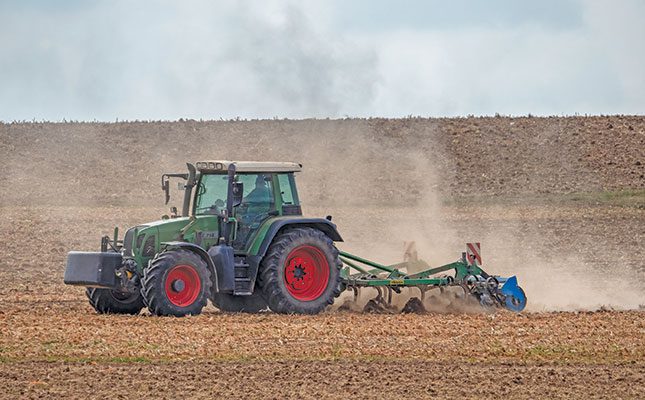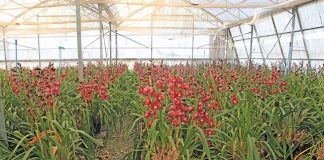
Photo: Wikimedia Commons
Why do producers have to change the way they farm?
Our world is in peril. Economies and societies globally are becoming more fragmented and disconnected, with the COVID-19 pandemic and the war in Ukraine revealing just how broken these systems have become.
We’re seeing increased antagonism between the US and China as power shifts from the west to the east, Brexit deepening the divide between the UK and EU, civil wars taking their toll in places like Afghanistan, Syria and South Sudan, and many domestic political challenges, not only in South Africa, but internationally.
Lawlessness from both the elite and the populist movements are on the rise.
Besides these man-made disasters, we also have natural disasters, such as droughts and floods, which are predicted to increase because of climate change.
The World Economic Forum publishes an annual global risk report. This year, six of its top 10 long-term risks were directly environmental, with only one, cybercrime at number 8, not having any environmental link.
We are hacking the world apart, and the problem is that there is no Planet B. Farmers are the principal custodians and users of land and water. As such, they have a major impact on food security as well as the health of the environment.
However, environmental degradation, the huge escalation in input costs, geopolitics, and adverse climatic conditions have rendered the conventional model of farming, where farmers add more and more chemicals and machinery to grow crops, unsustainable.
Over the past 15 years, for example, the number of dairy farmers in South Africa has decreased from 4 000 to fewer than 1 000.
Can you give an example of geopolitical issues?
To me, the EU’s stricter rules governing citrus imports from South Africa is an example of how food systems have become weaponised.
The EU claims these rules have been implemented to protect its farmers against false codling moth, but, in reality, the old rules offered sufficient protection. The new rules serve merely as a barrier to safeguard Spanish production.
The EU’s carbon border tax, on the other hand, is an example of an intervention created with good intentions – to fight off climate change – but with many unintended consequences. One of the biggest problems is the measurement of carbon emissions.
Spain pushed for carbon taxes, thinking it would reduce fruit imports from South Africa.
Carbon measurements, however, revealed that fruit imported from South Africa had a lower carbon footprint than that produced in Spain, because transportation by ship is more efficient than transportation by truck.
The solution from an agricultural perspective lies in sustainable, climate-smart agricultural practices. In other words, regenerative agriculture.
How do you define regenerative agriculture?
Many terms used in the sustainable agriculture space, such as organic, permaculture and biodynamic, are exclusionary. If you don’t fit into the niche, you’re not part of the approach.
Restore Africa Funds, however, believes that we need an inclusive approach if we want to solve agriculture’s current predicament.
Instead of forcing a set of rules, we look for a spectrum of principles aimed at breathing new life into the soil and, in effect, improving the climatic and financial resilience of farms.
Each farm has its own unique production system and climatic conditions. Applications also need to be adapted over time as a farming ecosystem evolves.
What is this spectrum of principles you refer to?
Firstly, we believe in minimal soil disturbance, which in practice means minimum- to no-till. This is because ploughing not only destroys soil organisms and their ecosystem, but exposes light- and air-sensitive organisms to light and air.
We do understand, however, that farmers might have to rip their lands once in a while when struggling with compaction layers. While this isn’t ideal, it’s better than ploughing the lands.
Increased biodiversity is the second principle. Nature is not a mono-organism; it consists of numerous species that provide ecosystem services in a symbiotic relationship with one another. It simply doesn’t make sense to try to grow crops sustainably in a monoculture.
The third principle is living root support. Approximately 40% of the carbohydrates produced by plants via photosynthesis are exuded via the root system in exchange for nutrients released by soil organisms.
Unfortunately, this symbiotic relationship is non-existent on most conventional farms. This means that up to 60% of the nutrients applied are leached or become unavailable to plants.
The fourth principle is increased soil protection through the use of cover crops and mulches to protect against evaporation and buffer soil organisms against extreme heat.
Having a cover also helps to protect the soil against erosion, while building up carbon levels in the soil improves its water-holding capacity.
What about animals?
Yes, that is the fifth principle. Livestock are living compost generators, providing eco-services when urinating, dropping manure, ruminating, drooling and grazing. They take low-quality food sources and convert them into high-quality protein.
Livestock, such as cows, get a bad rap because of their carbon emissions. However, the fault is not theirs, but of the people who manage them wrongly.
Rather than leaving a herd of animals in a camp for three months or longer, farmers need to use mob or ultra-high density grazing, where the movement and number of animals in a group is controlled to mimic the way in which herd animals would have moved in the wild. But there is progress towards adopting these techniques.
What are the outcomes of regenerative farming?
The use of regenerative farming principles helps to improve farm resilience and profitability by restoring the water, carbon and nutrient cycle, improving the soil structure, creating a favourable habitat for soil organisms, helping to unlock soil nutrients, and improving the water-holding capacity of the soil.
Ultimately, this results in plants better able to weather heatwaves, floods, droughts, pests and diseases.
Over time, this approach allows farmers to use fewer inputs, such as fertiliser and pesticides, and it may also improve the financial viability of a farm by creating new streams of revenue from the new crops or livestock added to the system.
So why aren’t more farmers changing?
Many farmers are still set in the ‘old ways’ of doing things. In addition, with farm income being under severe pressure, most farmers don’t have cash lying around to finance the switch.
Why is the change so expensive?
Well, you would have to invest in new implements and systems to change to regenerative agriculture.
Along with this, the switch generally means an initial drop in production. However, production usually stabilises at a level above a farm’s conventional long-term average after a number of years, depending on the severity of past degradation and water availability.
What is your solution to this challenge?
We launched private equity funds, called Restore Africa Funds, four years ago, because traditional agricultural financing doesn’t cater for farmers who want to switch from conventional to climate-smart, regenerative farming.
We have access to funding from various organisations, such as the Dutch Entrepreneurial Development Bank, and raised capital under section 12J of the Income Tax Act.
The fund’s capital structure offers a number of share classes, enabling investors to target specific outcomes, ranging from environmental to social impacts. Investors can also earn carbon credits to reduce their carbon footprint.
How does your offer differ from a production loan?
The fund is built on two pillars: ecosystem restoration, which is achieved through conservation and regenerative agriculture, and corporate governance best practices, as too many projects fail because of poor governance.
In addition, the fund is actively supported in executing this transition towards conservation and regenerative agriculture by four independent entities to ensure the success of each project.
Integrity Asset Management offers structure development, financial governance and investment management solutions; Wauko provides financial control and cash flow management solutions; Integra Trust is the custodian of the restorative ethos and provides on-farm extension services; and Asset Research is in charge of research, development and science communication.
How about the repayments?
Unlike a bank loan where you have to start repaying once the loan has been taken, our funding is structured to accommodate farmers during their transition period. It’s an equity investment in the regenerative agriculture operation, not a loan.
We share in the profits of the farming enterprise, so like the farmers, we don’t make any money when harvests are poor.
The fund therefore shares in the risk associated with the transition and with the farming business as such. This is significantly different to a conventional bank or production loan.
Email Nic van Schalkwyk at [email protected].











